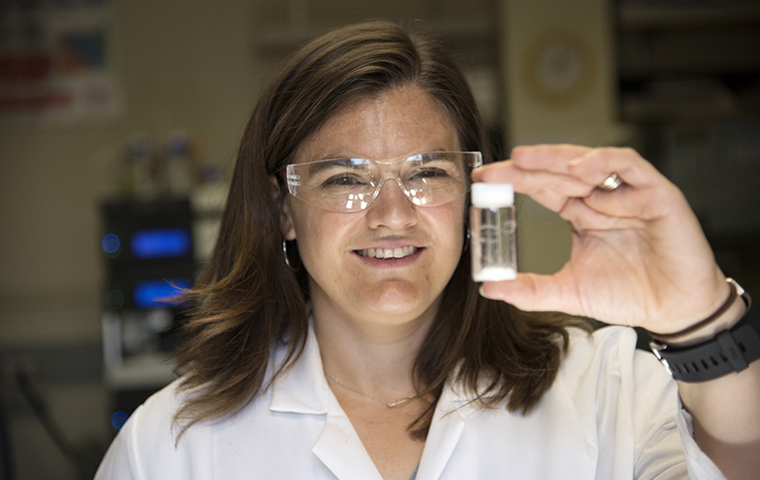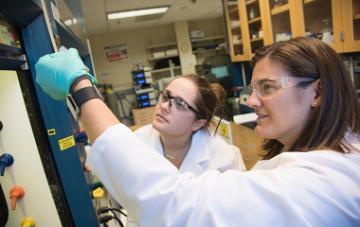
Sticky Science
Tina Vossugh
Amelia Fuller and student researchers harness the power of sticky molecules to fight pollution.
The molecules in Amelia Fuller’s lab are sticky, really sticky. And powerful, the associate professor of chemistry and biochemistry says. The small vials of white powder don’t look like much, but they’re contamination magnets when they hit the water.
The job of these molecules, called biomimetic oligoamides, is to stick to particles of pollutants. If there’s an oil spill or chemical leak at a factory, the presence of multiple chemicals in the water can interfere with tests to identify the contaminants, which ultimately makes it harder to clean.
The sticky molecules fix that. Scientists put the powder in the water, the molecules sense something that shouldn’t be there, cling to the particles of the pollutants, eliminate the interference, and make it easier to test and identify the chemicals for cleanup.
“The big picture goal is to find new ways to look for potential contaminants in water,” Fuller says. “There are ways to do this now, but this would give us a way to do it that’s more portable and more sensitive.”
This sticky molecule research won Fuller the Henry Dreyfus Teacher-Scholar Award for 2017 for excellence in research and dedication to education. Fuller started the research when she arrived at SCU in 2008. The $60,000 research grant that comes with the Dreyfus award will allow her team of student researchers — currently including Sam Hough ’18 and Kalli Dowell ’20—to focus on the project this academic year.
The process for testing is fairly simple. The students in Fuller’s lab contaminate a sample of water with a chemical. Next, using fluorescence spectroscopy, they shine a light with a specific energy and measure how much light energy is absorbed and how much is emitted.

Amelia Fuller (right) and student researcher Tara Karanik ’19.
“That tells us something about how the ‘sticky molecule’ and the contaminant are interacting,” explains Fuller. “Success in this specific experiment means the energy of emitted light changes when the contaminant is there versus when it's not there.”
But the sticky molecules aren’t a one-size-fits-all contaminant detector, Fuller says. Her team is working on several variations of molecules with sticky components— sticky molecule A, B, C, and so on—each with different traits and characteristics.
“If one of these nasty charcoal compounds interacts with two of them and another compound interacts with one of them, that’s okay because it’s not a one-to-one pattern,” Fuller says.
The team started their research with a class called polycyclic aromatic hydrocarbons (PAHs), which are pretty common and very toxic. PAHs are byproducts of combustion, like the black from charcoal grilling that causes cancer. They can get into water through oil spills, fossil fuel combustions, or even industrial wastewater.
Down the road, Fuller could see these sticky molecules pulling even more weight. Not only would they help identify the chemicals but they could potentially help clean them as well—which would be an incredible success for her students.
“Making these meaningful research experiences for students and engaging them in projects that advance knowledge, and have potential long-term impacts, that students get excited about is what brings me to work each day,” Fuller says.